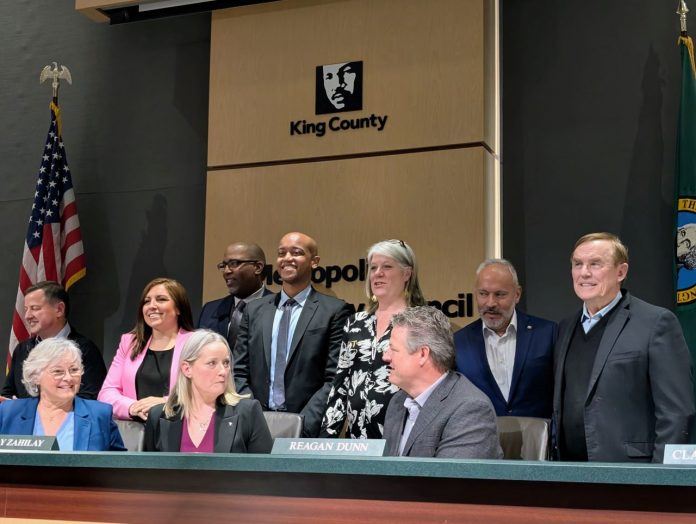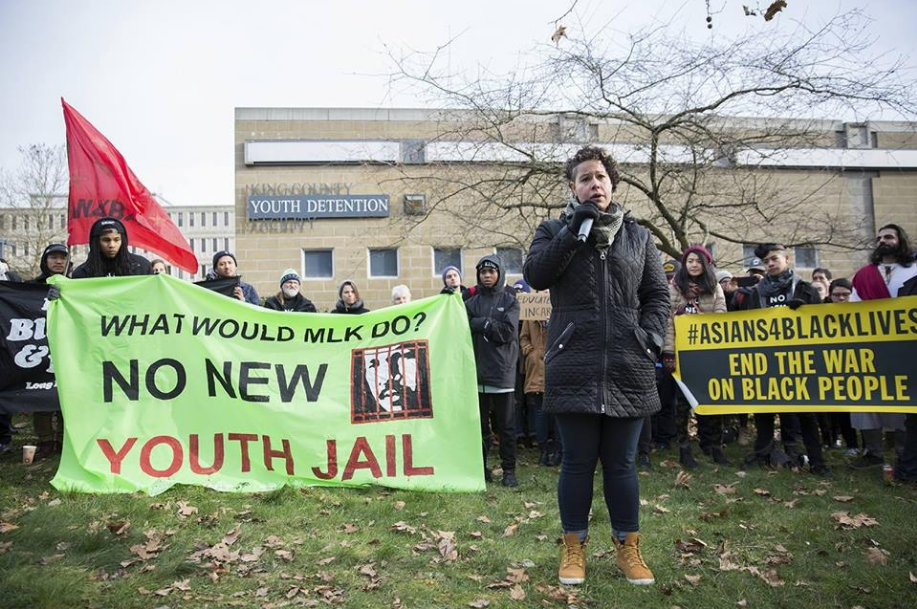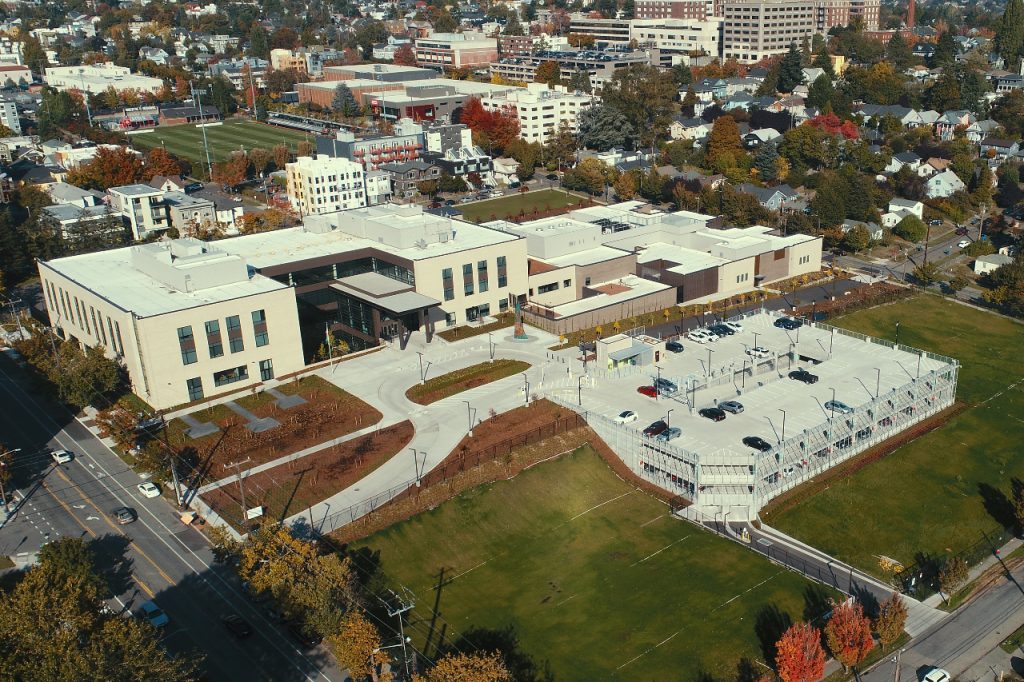
As King County officials work through the budget process, they are engaged in deciding the future of a restorative justice program diverting youth from the criminal legal system.
In the 2026-2027 budget, King County Executive Shannon Braddock proposed a series of changes to one of the county’s pre-filing youth diversion programs, currently called Restorative Community Pathways (RCP). The changes are extensive enough that RCP would cease to exist in its current form, its replacement a county-led program as opposed to community-led.
Signified by a name change to the King County Youth Diversion and Intervention Program, Braddock’s plan consists of both financial cuts to the program and organizational changes that would bring coordination and administrative work within the county’s Department of Community and Human Services (DCHS).
RCP has been hailed as an innovative community-based program, a collaboration between six different local community organizations with its Downtown Renton team as its organizational core.
Braddock’s plan would also eliminate funding for the positions of the RCP’s Downtown Renton team, which comprises the Youth and Family Fund, the RCP operations team, and six community navigators. The operations team is scheduled to be funded through the end of March 2026 and the navigators through the end of August.
“The Downtown Renton team, we’re a lot of the glue to the consortium because we handle the finances, the communications, the referrals, and we hold the Youth and Families Fund, which gets direct help to the families when they need it the most,” said Jasmine Vail, communications coordinator at RCP.
Should these changes be passed as part of the county’s budget, the DCHS would release a Request for Proposals (RFP) in early 2026, with community organization contracts to be finalized in September. A new administrative position within DCHS is anticipated to begin in April.
In a letter to King County Council Chair Girmay Zahilay about her proposed changes, Braddock references the King County Prosecuting Attorney Office’s (KCPAO’s) July announcement that the office would be pausing their referrals of youth felonies to diversion through RCP.
Braddock may have been influenced by a recent audit completed by the King County Auditor’s Office that found DCHS hasn’t been properly administering its grants, leading to improper payments and possible fraud. The only fraud noted in the report was one DCHS employee likely having dual employment and one or two organizations in the “Stopping the School-to-Prison-Pipeline” program submitting altered documents, the only one cited being a difference between $1,000 and $7,000.
DCHS expanded its grant-making capacity by 95% between 2019-20 and 2023-24, making growing pains likely, but mainstream media reporting on the audit claimed the county “may have given millions of dollars away in public money.” Additionally, an error on the auditor’s part led the initial report to vastly overstate the degree to which DCHS grants had grown, exaggerating by $900 million.
The audit reviewed four different youth programs funded by DCHS. RCP was only mentioned twice in the audit: once in which two organizations filled out prepaid card logs incorrectly and once in which one organization submitted an erroneous expense report, for which the County was later reimbursed.
“We submitted a corrective-action plan to the County this summer, and we have consistently adapted to the County’s contracting requirements as they’ve evolved,” an RCP press release stated. “We reject any suggestion by King County Councilmember Regan Dunn that RCP engages in fraudulent or wasteful practices.”
Nevertheless, Braddock moved to replace the program. At the heart of this decision lies two conflicting evaluations: one solicited by the KCPAO and conducted by Dr. Claus C. Pörtner, Professor of Economics at Seattle University and the other solicited by DCHS and conducted by Impact Justice, a national nonprofit.
The work of Restorative Community Pathways
Launched in 2021 in the wake of the George Floyd protests, with advocacy going back to 2012 and the No Youth Jail movement, RCP is a consortium of six community nonprofits in King County: Choose 180, Collective Justice, the Congolese Integration Network, Creative Justice, East African Community Services, and the Pacific Islander Community Association of Washington.

Offering an alternative to the court-based system for juveniles primarily between the ages of 12 and 18, RCP uses a community-led model of restorative justice to help both youth who have been accused of a crime and community members associated with these cases who have experienced harm. Youth can be referred to RCP by either the KCPAO or the community, and once engaged, they receive community supports and resources designed to help them heal and get their basic needs met.
Kids who have allegedly caused harm undergo a process of accountability through the program.
One of the stated goals of RCP is to reduce the disproportionate impact of the legal system on Black, Indigenous, and People of Color (BIPOC) youth and help them create better futures for themselves.
Aaron Vanterpool, nickname “Preme”, one of RCP’s community navigators who works in downtown Renton, says he’s available to the youth he’s helping 24/7 by phone. The kids in his caseload range from being homeless to being involved in domestic violence situations, having trouble in school, or struggling in the foster care system. He acts as a mentor, doling out advice and support while connecting the kids to services and opportunities: skills training, resume building, money for transportation to job interviews and classes, money for food and clothing for their households, and more.
“A lot of the kids that are coming to us are underserved and underprivileged, unfortunately, but we do deal with a wide variety of kids, and I really think that the work that we do helps the promotion of their brain function, their maturity, their education, and things that they were not receiving from different places in their lives, and they wouldn’t be receiving from just being put in a jail cell or pushed down that path,” Vanterpol told The Urbanist. “I think we are definitely a deterrent for whatever factors that led them to us in the first place.”
Meanwhile, support for harmed parties can look like financial restitution for anything lost or damaged during alleged incidents, which can help people feel whole and retain their employment. Harmed parties are also offered access to services like therapy, job counseling and training, food, and more stable housing.
“Unfortunately, the normal traditional justice system does not provide that support for harmed parties, and that may cause animosity between community members,” Vanterpool said. “As a restorative-based program, we are able to make those connections and create those bonds, and actually have those kids that came in as maybe an alleged [person who caused harm] and a harmed party, now they’re friends, and now they’re doing pro-social activities together and really building each other up.”
Recent evaluation of RCP
DCHS contracted with the nonprofit Impact Justice to provide an independent evaluation of the RCP program, which was released just a few weeks ago.
The evaluation cites systemic inequities such as housing and food instability and caregiver incarceration, as well as racial bias, punitive school environments, and unmet basic needs as creating huge challenges for youth, especially those who are marginalized.
“These conditions create pathways into the legal system for young people who may have high needs but pose little risk to public safety,” the report reads. “Often, they are experiencing trauma, behavioral health issues, or family conflict—challenges better addressed through supportive services rather than legal intervention. Research consistently shows that formal system involvement can leave youth worse off, increasing the likelihood of re-arrest, incarceration, and long-term instability.”
In 2024, the report says there were 2,328 cases involving youth referred to the KCPAO for legal system involvement, representing about 1,595 individuals. Of these cases, 45% were misdemeanors, while 18% involved property crimes, drug-related offenses, and other felonies. A quarter of the cases involved the use of a weapon or crimes against a person.

Charges were filed in 38% of the cases, 18% of these involving a misdemeanor. One third of cases were diverted.
Male youth represented 73% of legal system referrals, and Black youth made up 42% (compared to 7% of the total population).
The evaluation highlighted key findings about Restorative Community Pathways:
- RCP is good at meeting the basic needs of both youth who have allegedly caused harm and those who have been harmed, with 93% and 98% expressing satisfaction respectively;
- Roughly two quarters after enrollment, 80% of diverted youth and 72% of harmed parties were reported as actively engaged in the program;
- RCP helps the people it serves meet their goals, with 69% of diverted youth and 84% of harmed parties meeting at least one of their stated goals;
- 59% of male youth diverted and 58% of female youth diverted completed the program;
- Participation is driven by trust, individualization, and creating partnership with families;
- Challenges facing the program included an expedited launch, negative media representations, skepticism, budget constraints, and lack of availability of certain services, such as affordable housing, substance use treatment, and long-term behavioral health care. .
The evaluation recommends the RCP consortium increase their collaboration and hire a consortium coordinator. It seems likely the reboot of these diversion services under the County’s umbrella will instead decrease coordination between organizations selected via the request for proposals application process.
The evaluation, citing evidence-based practices, also recommends RCP consider expanding its program eligibility criteria to include youth facing more serious charges. Again, this is exactly the opposite of what the proposed changes will accomplish.
Finally, the evaluation suggests improvements to data collection practices, including hiring an external expert for technical assistance.
“Despite the challenges outlined above, the RCP model represents a promising and innovative approach to youth diversion—one that centers healing, community engagement, and racial equity,” the report concludes. ”With continued investment, strengthened infrastructure, and a renewed commitment to its community-led foundation, RCP has the potential to deepen its impact and serve as a national model for jurisdictions seeking to transform their approach to youth justice.”
Incomplete report
However, Impact Justice couldn’t perform an analysis of the recidivism of RCP program participants as was intended. The KCPAO refused to give Impact Justice the necessary data to conduct any analysis.
Instead, the KCPAO solicited their own recidivism evaluation from Pörtner. When The Urbanist reached out to ask why the data hadn’t also been provided to Impact Justice, KCPAO spokesperson Douglas Wagoner said, “We wanted to be sure any report produced using the data was done so objectively and independently, and not tainted by any of the issues involving a potential conflict of interest.”
When the KCPAO learned that DCHS had contracted with Impact Justice for the evaluation, the KCPAO’s Stephanie Trollen, Operations and Restorative Programs Manager of the Juvenile Division, wrote a letter to various people in DCHS and KCPAO expressing concerns around a conflict of interest.
“I believe some members of DCHS may have met with Impact Justice and the RCP consortium when they served as consultants in the design and implementation of Restorative Community Pathways,” Trollen wrote. “Impact Justice was also very helpful when RCP first came under public scrutiny which is when they drafted the attached letter of support of RCP.”
However, both DCHS and Impact Justice told The Urbanist that Impact Justice played no role in the design and implementation of RCP.
“The organization [Impact Justice] was selected through an intensive screening process in partnership with the County’s Procurement Office to develop this report and Impact Justice meets DCHS’ standard of objectivity,” DCHS further told The Urbanist.
Antoinette Davis, the vice president and director of the Research and Action Center at Impact Justice, told the Urbanist that writing a letter of support is a common practice in the nonprofit space.
Additionally, the research arm of Impact Justice has a firewall in operations, operating distinctly from other staff and with measures to ensure security and confidentiality. The restorative justice project is no longer a part of Impact Justice, having spun off to become its own entity.
“We’re a completely ethical team,” said Lallen Johnson, the associate director of the Research and Action Center at Impact Justice. “We are a team composed of three PhDs with training in the field of criminal justice, two individuals with training in criminal justice PhDs, another one with training in psychology. We have all received substantial ethical training regarding the study of criminal legal systems.”
Apart from Davis, the entire research team was not hired until March 2024, years after the design and implementation of RCP in King County.
The question of recidivism
Upon receipt of Pörtner’s report, King County Prosecuting Attorney Leesa Manion wrote, “The initial report shows a 24-month recidivism rate of 53.2% for felonies. As a result, the KCPAO is making the decision to pause felony diversion referrals to RCP pending the results of Professor Pörtner’s secondary analysis, which seeks to evaluate and compare recidivism rates for RCP vs. those of traditional prosecution.”
In his report on the RCP, Pörtner wrote, “Several significant study limitations necessitate caution in interpreting the results of this report; these include relatively small sample sizes, newness of the program, lack of a comparison group, and unique impacts of the COVID-19 pandemic.”
Manion echoed the need for caution in her memo, but still made the decision to pause felony referrals.
In her memo, Manion referenced a report on juvenile recidivism from the Washington State Center for Court Research (WSCRR) analyzing data from 2014-2015. However, two experts in the field–Sarah Cusworth Walker, a research professor at the University of Washington’s Department of Psychiatry and Behavioral Sciences and Katherine Beckett, a sociology professor at the University of Washingtion–disagree with which data from that report is most appropriate as a benchmark.
According to the data they find more comparable, the felony recidivism rates for RCP are very similar, with 53.2% at 24 months of RCP vs 54% at 18 months in the WSCRR report.
“Taken together, the lack of a direct comparison in the PAO analysis, along with the best available benchmark data showing comparable recidivism rates, lead us to conclude that the PAO’s decision to pause referral to the RCP is unsupported by the available data,” wrote Walker and Beckett.
Jess Rock, Collective Justice’s Grants and Contract Manager and Facilitator, also called Pörtner’s report into question.
“These figures show that in just four years, RCP’s outcomes are at least as effective as the traditional system, one that has operated for over a century with persistent inequities and traumatizing results,” Rock told The Urbanist. “Too often, innovative community-led efforts like RCP are the first to be undermined at the first sign of challenge, while the carceral system that has failed generations of young people continues unchecked. There is always room to strengthen this work, and those of us committed to healing and accountability are doing exactly that. But scrutiny should be even-handed especially when the data shows that the approach piloted by RCP has shown great success.”
Impact Justice’s Johnson expressed another issue with Pörtner’s report: namely, that it uses police referrals to determine recidivism rates.
“In the study of criminal justice, when we measure recidivism, we try to avoid things such as police stops or police arrests, or in this case, say, referrals on behalf of the police,” Johnson said. “And there’s a good reason for that. We know that certain communities receive more levels of policing than the others. So it doesn’t really make sense to base recidivism based on contact with the police. Consider how much variation there is in policing across neighborhoods. That’s essentially the data they reported on, which is referrals.”
A best practice would be to instead measure recidivism based on youth with new sustained charges.
Both Davis and Johnson expressed interest in being able to perform a recidivism analysis of the RCP program based on best practices.
Wagoner told The Urbanist that the secondary analysis by Pörtner is currently in the works, and that the KCPAO hopes to have an update in the coming months.
King County Council to make final decision
Due to Manion’s decision to pause felony referrals to RCP, Braddock announced her intentions to cut $1.65 million from the youth diversion program for the 2026-2027 biennium, saying the other changes to youth diversion are based on recommendations from DCHS.
King County Councilmembers Teresa Mosqueda, Jorge Barón, and Rod Dembowski have been discussing the changes during the Health, Housing, and Human Services budget panels over the last few weeks.
Mosqueda wants to make a few changes to Braddock’s proposal: to provide additional funding to allow a smoother transition between RCP and Braddock’s proposed King County Youth Diversion and Intervention Program, making sure there is overlap between the two programs, and to remove the proposal’s restriction on the possibility of youth felony diversion.
Matt Sanders, the Director of the King County Department of Public Defense (DPD), agrees with keeping the door open for youth felony diversion in the future.
“King County must maximize opportunities for diversion from a youth legal system we know is harmful and disproportionately targets youth of color,” Sanders said. “Diversion programs should broaden access for the young people most in need of support, based on individual circumstances, not case type. We must invest in restorative responses that strengthen youth and communities — not categorically exclude youth charged with certain offenses.”
Vanterpool also believes in the value of youth diversion for felony cases, emphasizing that these cases generally involve kids who need more attention and help.
During the council budget panel, Dembowksi spoke more critically of RCP.
“What I am interested in is having a break from the old existing program, which I don’t believe has demonstrated fidelity to the principles of transparency, accountability and appropriate use of public funds in all respects,” Dembowski said. “I also believe that there needs to be a paradigm shift in the philosophy of this program.”
Dembowski would like to have council approval of what the new model for youth diversion looks like.
Barón is concerned kids might fall through the cracks during a transition and wants the new diversion program to have clearly stated goals.
“I feel like we as a community have not necessarily always been in agreement as to exactly what we’re trying to achieve here,” Barón said. “Is it just reduce recidivism? Is it actually focus on the youth and providing support? I think there’s a combination of factors there. But how do we measure success?”
The option of preserving RCP instead of replacing it has not been discussed.
The King County budget is scheduled for final approval by the council on the morning of November 18, with opportunities for public comment on November 12 and 13.
Meanwhile, RCP is looking into the possibility of turning their Downtown Renton team into a new organization so they can apply through DCHS’s RFP process in a few months. This would give them a chance to continue working with the youth and community they’re serving.
“I do think that we are on the cutting edge of a new normal for the United States,” Vanterpool said. “So I hope that we can continue to explore these innovative and groundbreaking programs and continue to support them as a community.”
Amy Sundberg is the publisher of Notes from the Emerald City, a weekly newsletter on Seattle politics and policy with a particular focus on public safety, police accountability, and the criminal legal system. She also writes science fiction, fantasy, and horror novels. She is particularly fond of Seattle’s parks, where she can often be found walking her little dog.

